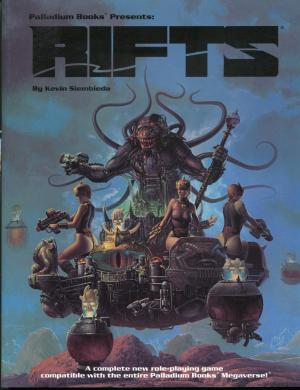
Remember what I said about Kevin Siembieda’s writing being like a fountain of mad ideas hitting paper? Rifts is that writ large.
Around 1990, an idea emerged in the games industry. It may have been born out of the sheer number of games on the market, or it may have come from the success GURPS enjoyed. That idea was a multi-genre, single setting, role playing game.
There were two main proponents of this approach. There was West End Games’ TORG, which I never played, but always wanted to. And then there was Palladium’s post-TMNT hit, Rifts.
Rifts is pretty much Siembieda’s previous games (Palladium Fantasy Role-Playing Game, Heroes Unlimited, Beyond the Supernatural and Robotech) thrown into a blender. You’ve got wizards, super powered aliens, Lovecraftian horrors and giant robots all inhabiting the same world.
Unsurprisingly, this means the game is horribly unbalanced. At least in the early editions. I have heard that the modern iteration of the game is more solid in its design. But back in the day you were dealing with a game system that got so out of control in terms of rules, character classes and settings that they ended up selling a separate index to the game.
That ran to two books.
They also produced a Rifts Colouring Book.
This situation was kind of the endemic of the games market as a whole in the nineties, as games began to choke on their own settings. While bad decisions like Dragon Dice were more the downfall of TSR, the sheer number of setting and settings in those settings didn’t help. Likewise, the World of Darkness line choked on White Wolf’s attempt to maintain some sort of in game continuity.
So you went from a market in the 80s that was distinguished by masses of games which led to the multi-genre games, to a market that was now distinguished by masses of sourcebooks for existing games. Either way you had lots of people buying lots of game books that they never used.
Your typical Rifts book would be full of poorly laid out background material for a geographical location that seemed to only exist to add a ton more character classes, magic and equipment options into an already stuffed to bursting game. Oh, and some new monsters to kill. Or play as Racial Character Classes.
Not all these classes were balanced either in terms of power or material supplied, and you were best not mix and matching between books or you might find yourself playing a wizard or dragon surrounded by ninjas jacked to the gills on cybernetics who spent every session fine tuning their equipment lists.
Despite that imbalance and rules/setting bloat, the fact that there is just so much utter madness slung together makes it a fun game. I had a great time playing a Time Wizard, blowing up evil pyramids in Glastonbury by sending bombs into the future.
Like Mutant Chronicles, Rifts was one of those 90s games that had ambitions of becoming a multimedia franchise. It did eventually make it to videogames. Unfortunately the Nokia N-Gage was the platform.
One last note, back when I first got on the internet at university, there was this DarkWorld RPG that was mentioned on rec.arts.anime. It was basically an anime flavoured rip-off of Rifts, that started off hiding its influence in a thinly veiled fashion like Mayfair’s unlicensed D&D accessories, before giving up with this file that just went ahead and listed Palladium stats for The Dirty Pair, Lum and The Sailor Scouts.
It’s not that surprising that it existed given Palladium’s history with Robotech and Macross II games, but the amount of effort that had gone into it still leaves me gobsmacked today. I’m a lazy gamer and do as little prep as possible, preferring to improvise, so this sort of exercise in cataloguing a world and stats is alien to me.
I’m presuming that the Tony Figueroa who wrote it is the same Tony Figueroa who is now the chair of the Fanime convention. Can anyone confirm that?
i need to know if i can find any of the origanal rifts source books can you link me any where?